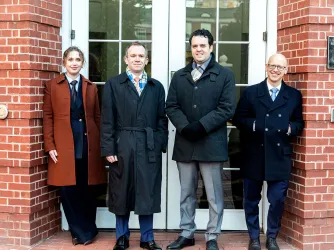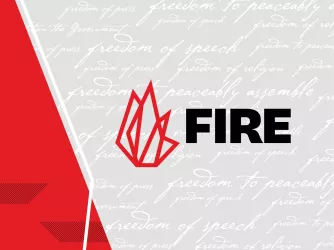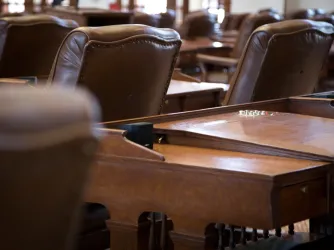Table of Contents
Ninth Circuit Rules in Favor of Oregon State Student Newspaper
Yesterday, the United States Court of Appeals for the Ninth Circuit issued a victory for student speech rights in Oregon State University Student Alliance v. Ray. The case concerns Oregon State University's (OSU's) treatment of the Liberty, a conservative student newspaper that OSU administrators essentially attempted to shove off campus—first by confiscating and trashing the Liberty's newsbins, then by citing an unwritten policy to prevent the Liberty from being distributed across campus like other publications.
The case isn't over—yesterday's ruling overturns the district court's dismissal of the student editors' and publishers' claims, sending the case back down and allowing it to proceed. Nevertheless, the Ninth Circuit reached some important, speech-protective conclusions that will benefit not only the Liberty, but future students seeking to vindicate their rights in the Ninth Circuit.
Let's review the facts first. Writing for the panel, Judge A. Wallace Tashima briskly summarizes the basic dispute:
The complaint alleges that employees in Oregon State University's Facilities Department gathered up the outdoor newsbins belonging to the Liberty, a conservative student monthly, and threw them in a heap by a dumpster in a storage yard. The employees acted pursuant to an unwritten and previously unenforced policy governing newsbins on campus. They did not notify anyone at the Liberty before confiscating the newsbins. After the confiscation, University officials denied the paper permission to replace the bins anywhere but in two designated campus areas — limited areas to which the University's traditional student paper, the Daily Barometer, was not confined.
You may be asking yourself: Really? OSU administrators seized a student paper's newsbins, then dumped them in the trash? Amazingly, the answer is yes. Judge Tashima explains:
In 2005, OSU Students Alliance [the Liberty's publisher, and a registered student organization at OSU] placed eight new bins around campus. OSU Students Alliance placed the bins in the areas of campus with the heaviest student traffic — near the bookstore, dorms, football stadium, and other locations. Most of these locations already had the Barometer bins, and OSU Students Alliance's goal was to place bins next to the Barometer so that students would pick up a copy of both student newspapers. After one bin was stolen, OSU Students Alliance used wire bicycle chains to secure the remaining seven bins to nearby light or sign poles. In total, the Liberty had seven outdoor distribution bins.
[...]
During the 2008-09 winter term, all seven of the Liberty's outdoor distribution bins disappeared from campus. The bins of the other papers, including the other off-campus papers, were left untouched. Because OSU had given the Liberty permission to place its bins at specific locations throughout campus, and had not revoked that permission, the Liberty's editors had no reason to suspect their bins had been confiscated by the University. Thus, they called the police. Only through the police investigation did they learn of the University's involvement. After contacting the Facilities Department, the student editors recovered the seven newsbins from the storage yard, where they had been left "heaped on the ground." One bin was cracked and others had spilled open, resulting in the loss of 150 copies of the Liberty to water damage. The wire bicycle locks that the editors used to secure the bins against theft had been cut. [Emphasis added; internal citations omitted.]
After fielding complaints, university administrators explained to William Rogers, the Liberty's executive editor, that OSU was cracking down on newsbin placement under a 2006 policy. Rogers was told that the Liberty could only position newsbins in two locations on campus moving forward because it was an "off-campus" paper—unlike the Barometer, which would continue to be allowed newsbins throughout campus.
Rogers was unsatisfied with this explanation. After all, the Liberty was written, edited, funded, and published by a student organization, even though it accepted private funding and advertising revenue. Rogers pressed administrators for an exception; denied one, he asked for a copy of the 2006 policy under which the Liberty could apparently only set up newsbins in two locations. Incredibly, OSU's associate general counsel told him that the policy didn't exist, telling Rogers that "[t]here is no specific written policy that governs the placement of publication bins, and none is required."
Demonstrating admirable patience, the Liberty's editors drafted a proposed new policy to allow both the Liberty and the Barometer equal access to campus. When that effort was (unsurprisingly) denied as well, the Liberty's student publishers and editors filed suit, alleging a violation of their First Amendment, due process, and equal protection rights. (Fun facts: The plaintiffs are represented by former FIRE Legal Intern Heather Gebelin Hacker, now legal counsel for the Alliance Defending Freedom.)
In response, OSU quickly crafted a new written policy regulating newsbin placement, prompting the district court to rule the Liberty's claims moot, dismiss their damages claim, and deny their motion to amend. The Liberty appealed, and the case headed up to the Ninth Circuit on appeal.
With the background covered, let's get to the meat of yesterday's ruling.
The first key holding from the opinion is the Ninth Circuit's determination that OSU's campus is, at minimum, "a designated public forum." What does this dry legalese mean? Well, when a court reviews the constitutionality of speech restrictions imposed by the government on its own property-including public campuses like OSU—it first makes a determination about the type of "forum" the property is, looking to government classification and traditional usage. Different types of forums allow for different levels of speech restriction. For example, speech restrictions in a "limited public forum" only need be viewpoint neutral and reasonable in light of the forum's purposes, which grants the government broad leeway to regulate speech. But in a "designated public forum" or a "traditional public forum," the government's ability to regulate speech is sharply curtailed. In those forums, a court will review restrictions on speech with "strict scrutiny," meaning that any regulation must not only be viewpoint neutral, but also narrowly tailored to serve a compelling governmental interest. In practice, that's a much higher hurdle for the government to clear.
So by labeling OSU's campus "at least a designated public forum," the Ninth Circuit makes clear that it will hold OSU's speech restrictions to a high standard of review. That's good news for college student speech rights. We here at FIRE have watched colleges in recent years attempt to unilaterally declare their campuses "limited public forums"—the University of Cincinnati recently failed in its attempt to make this argument in court—in order to allow themselves broad leeway to silence student speech. After reviewing OSU's policies and practices, both of which indicated that OSU's campus was open to student speech, the Ninth Circuit wasn't buying that argument here.
Nor did the Ninth Circuit accept OSU's argument that the imposition of the newsbin policy effectively rendered the campus a limited public forum, another key holding. The court knocked down this reasoning as circular, pointing out that if "speech restrictions in a designated public forum automatically constituted limitations on the scope of the forum itself, then the concept of the ‘designated public forum' would merge entirely with that of the limited public forum." As a result, the government would be far freer to turn designated public forums into limited public forums. Instead, the court required OSU to meet a higher burden to show that what was once a designated public forum was now a limited public forum than simply pointing to a policy: "To destroy the designation of a public forum, the government must do more. It must consistently apply a policy specifically designed to maintain a forum as non-public." And because OSU's policy was unwritten, it failed to meet that hurdle.
Speaking of that unwritten policy, the Ninth Circuit minced no words in making its assessment clear:
The policy that OSU enforced against plaintiffs, however, was not merely unwritten. It was also unannounced and had no history of enforcement. It materialized like a bolt out of the blue to smite the Liberty's, but not the Daily Barometer's, newsbins onto the trash heap. The policy created no standards to cabin discretion through content or history of enforcement, and it set no fixed standard for a distinction between the Barometer and the Liberty. The policy's enforcement against plaintiffs therefore violated the First Amendment. [Emphasis added; internal citations omitted.]
Pouring it on, the Ninth Circuit proceeded to note that the associate counsel's attempt to distinguish the Liberty from the Barometer "raises the ominous specter of viewpoint discrimination" and smacked of an after-the-fact rationalization. What's more, the Ninth Circuit found that the unwritten policy wasn't a reasonable time, place, and manner restriction, as the university argued, because it was completely devoid of any specific standards, rendering assessment impossible and allowing administrators unbridled discretion to silence speech they simply didn't like. Indeed, Judge Tashima labeled the associate counsel's attempts to explain the unwritten policy's application to the Liberty but not to the Barometer "Orwellian." Add it all up, and the Ninth Circuit reversed the district court, ruling that the plaintiffs' First Amendment damages claim was adequately plead.
Turning to the equal protection claim, the court echoed its First Amendment analysis, finding that the plaintiffs' claim may proceed because it properly alleged "differential treatment that trenched upon a fundamental right"—specifically, the university's use of the unwritten policy to silence the Liberty while giving the Barometer a pass. And the Ninth Circuit reached a similar conclusion with regard to the due process claim, holding that because OSU had enforced the unwritten policy without any notice whatsoever, the due process violation was adequately pled.
Having found the constitutional violations all adequately pled, the Ninth Circuit finally turned to the question of causation, a crucial determination. This is where the Ninth Circuit's ruling gets tricky—and interesting. Heeding the Supreme Court's ruling in Ashcroft v. Iqbal, 556 U.S. 662 (2009), the Ninth Circuit notes that to state a valid claim of a constitutional rights violation, plaintiffs "must allege that every government defendant — supervisor or subordinate — acted with the state of mind required by the underlying constitutional provision." For the unconstitutional discrimination claims at issue in Iqbal, for example, the Supreme Court held that plaintiffs must allege that the government actor in question (there, former Attorney General John Ashcroft) had acted with specific intent to discriminate—i.e., with the purpose of doing so. And for violation of the Eighth Amendment's prohibition of cruel and unusual punishment, plaintiffs need only allege deliberate indifference, which means that a sheriff "is liable for prisoner abuse perpetrated by his subordinates if he knowingly turns a blind eye to the abuse" and "need not act with the purpose that the prisoner be abused" himself.
So what's the requisite state of mind for alleged violations of free speech rights? That's the question the Ninth Circuit wrestles with in regard to the student's claims against OSU's president and vice president, neither of whom physically junked the newsbins themselves, although each allegedly knew about and approved the actions taken by their subordinates.
In a welcome development for student speech rights, the Ninth Circuit's review of Supreme Court case law lead them to conclude that "allegations of facts that demonstrate an immediate supervisor knew about the subordinate violating another's federal constitutional right to free speech, and acquiescence in that violation, suffice to state free speech violations under the First and Fourteenth Amendments." Because OSU's president and vice president "stood superior to [OSU's Director of Facilities Service Vincent] Martorello; they knew that Martorello denied plaintiffs' publication the same access to the campus that the Barometer received; and they did nothing," the Ninth Circuit found that they were properly named.
This is a useful development for student speech rights, because it means that high-ranking public university officials who tacitly give a stamp of approval to unconstitutional speech codes or other speech violations on campus won't be allowed off the hook simply because they weren't the ones enforcing the policy. If the president of a university knows that student speech rights are actively being violated, but takes no action to end the violation, he or she can expect to be named as a defendant when a lawsuit is filed.
(The Ninth Circuit reached a different conclusion with regard to due process rights, however, concluding that the "complaint does not tie President [Ed] Ray and Vice President [Mark] McCambridge to the confiscation, through the policy or any other means." Check out the opinion for the full discussion of the difference between the state of mind requirements for due process and free speech violations in this context, and note Judge Ikuta's dissent regarding Iqbal's requirements.)
Again, this case isn't over yet, and has now been remanded to the district court for further proceedings. Per the ruling, the students will also now be allowed to amend their complaint, so we'll have more on this case as it proceeds at the district court level. In the meantime, however, the litigation here has already secured important developments for student speech rights in the Ninth Circuit.
As always, we'll keep you posted here on The Torch.
Recent Articles
Get the latest free speech news and analysis from FIRE.

VICTORY: Jury finds Tennessee high school student’s suspension for sharing memes violated the First Amendment

DOJ must not investigate elected officials for criticizing immigration enforcement

FIRE statement on calls to ban X in EU, UK
